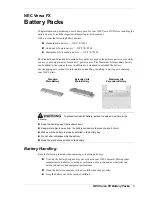B. Easy Environment
1
2
These handles determine
HOW MUCH
support a patient will have in easy
environments (light gray)
1. Neural Noise Suppression -
Easy
‑ Amount of noise suppression for easy situations (light gray).
‑ Choose this control if patients are struggling in situations that are
considered more simple environments.
Ask patient: Do you find background sounds to be disturbing
sometimes, even in quieter situations?
2. Virtual Outer Ear -
Easy
‑ Compensates for loss of pinna effect.
‑ Choose this control should the patient want more/less of a front
focus.
‑ Options for Virtual Outer Ear in easy environments:
‑ Aware
‑ Balanced
‑ Focused
Ask patient: Do you want to be very aware of all sounds around you or
focus a bit more on someone in front of you in quieter situations?
3
4
These handles determine
HOW MUCH
support a patient will have in difficult
environments (dark gray)
3. Neural Noise Suppression -
Difficult
‑ Amount of noise suppression for difficult situations (dark gray).
‑ Choose this control if patients are struggling in more complex
environments.
Ask patient: Do you find background sounds to be disturbing when
there are many sounds around you?
4. Sound Enhancer -
Difficult
‑ Allows for additional boost from 1000‑4000kHz when MSI is actively
working to control noise in difficult environments.
‑ Choose this control should patients want more support in difficult
environments.
‑ Options for Sound Enhancer for difficult environments:
‑ Detail
‑ Balanced
‑ Comfort
Ask patient: When listening to speech in difficult situations, are you
sometimes overwhelmed or do you prefer to have more speech detail?
C. Difficult Environment
MoreSound Intelligence at follow-up appointment
Adjusting Easy and Difficult environments: How much support is needed?
16
17


















